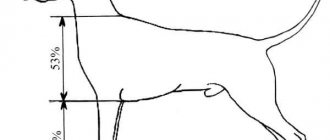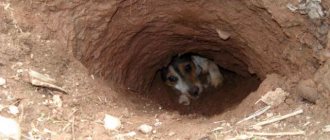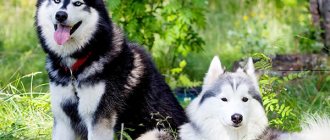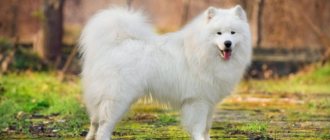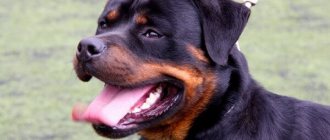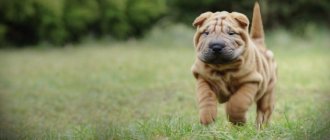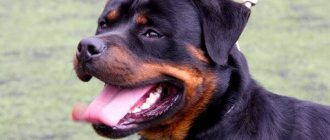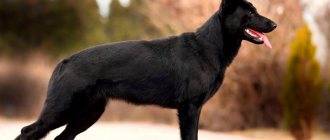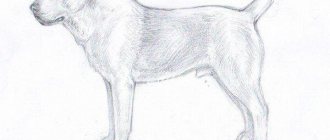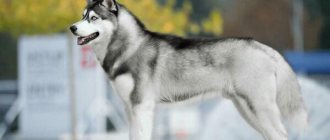Labradors are considered one of the most popular dog breeds these days.
Because of their friendly nature and easy-going nature, they have become family members and best friends for many.
These dogs fit perfectly into people's lives and filled it with emotions and new impressions.
After all, Labradors can add variety to even the most boring life.
ov to success
Instructions for buying a Labrador for beginners
So you've decided to get a dog. This will be your first dog, or perhaps you had a dog as a child, which you equate to having experience. Making the absolutely right choice is difficult even for professionals who have been keeping and breeding dogs for decades, since the ideal did not exist and cannot exist. However, there are a number of typical buyer mistakes that breeders are well aware of, but most often keep silent about. Since we are not engaged in large-scale breeding and do not aim to actively sell puppies, we will still publish our personal Instructions for beginners who want to get their first Labrador in “simple words.” The most important thing we will talk about below:
Dysplasia
This is a common and quite serious joint disease. It is becoming more common in Labrador dogs. Therefore, before using an animal for breeding, it is advisable to take x-rays of it. According to experts, this pathology develops under the influence of several different factors. It can be triggered by genetics, excess weight, an unbalanced diet, high levels of calcium and phosphorus, excessive exercise or limb injuries.
This paw disease in Labradors is accompanied by limping and swaying when walking, swelling or swelling of the joints. Symptoms characteristic of dysplasia also include pain in the elbows or hips, body asymmetry, unusual lying posture, stiffness of movement and fatigue.
This pathology can be diagnosed through radiography, but the only way to get rid of it is through surgery. To alleviate the condition, a sick dog is usually prescribed maintenance therapy, which includes a whole range of medications. As a rule, veterinarians prescribe chondroprotectors, antispasmodics and anti-inflammatory drugs to four-legged patients.
Pros and cons of Labrador mixes
The Labrador Retriever is one of the kindest animals. Hybrids of this dog breed usually have a lot of additional positive qualities:
- goodwill;
- high intelligence;
- good learning ability;
- good health;
- unpretentiousness in nutrition.
Cons: Unpredictability of exterior and character. When mating with rather aggressive and wayward breeds, the offspring may inherit far from the best qualities of the parents. However, they can still be adjusted through proper education and training.
Purchase rules
Before choosing a puppy, you should decide why you need a dog. If you plan to represent your friend at shows, then you need a dog with ideal characteristics. And if you just need a smart, loyal four-legged friend, you don’t have to buy a puppy from champion parents.
Nobody buys or sells newborn puppies. The optimal age for an animal to find new owners is 3-6 months. At this age it is already possible to at least approximately determine what the dog will be like when it grows up. If you decide to purchase a Labrador, try not to save money, since the risk of buying a sick puppy at a low price is very high. The nursery should give you a veterinary passport and a kennel club card. In addition, the breeder provides all the necessary recommendations for caring for the animal (choice of food, antihistamine treatment, vaccinations). A responsible breeder advises that if any problems arise, you should contact him.
What does a dog look like according to the RKF?
- Torso . The Labrador's back line should be straight, the croup should be short and strong. There should be no hunchbacks. Labradors have a wide chest, barrel-shaped ribs, well-defined withers, and a medium-length tail, wide at the base and tapering towards the end. It’s hard to imagine Labradors without such an otter-like tail. It should be located horizontally to the lower back. In the active state, it can be slightly raised, but a crescent shape or bend behind the back is not allowed.
- Head and muzzle . Labradors have a large and massive skull, which stands out a little from the whole image. The cheeks are dry, not fleshy. The muzzle is slightly wide, not too long. Narrow or short is not allowed. The nose is large, with wide nostrils. Labradors' ears are in a hanging position and slightly behind the head. Should not be too long or heavy. The eyes have a friendly and intelligent appearance; only dark shades and medium-sized irises are allowed. The bite is scissor-shaped and the upper jaw completely covers the lower jaw. The neck is dry, long and without folds.
- Fore and hind limbs . The general appearance of the limbs is strong and muscular, located parallel to each other. The length of the forelimbs is equal to half the length of the animal at the withers. The pasterns are in the same plane as the forearm, the hock joints are clearly visible.
- Wool. Labradors have short hair, often short. It is hard to the touch, with a dense and dense undercoat underneath. The main feature is water resistance.
Osteochondrosis
This is a severe pathology, accompanied by joint damage and cartilage degeneration. It occurs in dogs of different ages and leads to irreversible consequences. Most often it affects the hock, knee, elbow and shoulder joints. But sometimes the pathology spreads to the spine.
Osteochondrosis develops gradually. In the initial stages, the dog is reluctant to stand up and moves carefully after getting up. In some cases, the four-legged patient experiences an increase in the affected joints. The animal experiences severe pain and rarely changes body position. In severe cases, the dog loses control of the limbs but retains sensation.
This pathology begins to develop as a result of injury, excess weight, hypothermia, increased physical activity, excess calcium and rapid weight gain with insufficient bone strength. In addition to all the above reasons, Labradors have a breed predisposition to osteochondrosis. Heredity affects the degree of development of capillaries located around the joints and the elasticity of cartilage tissue.
Treatment of osteochondrosis should be carried out by an experienced veterinarian who can correctly assess the condition of the animal and the degree of damage. Therapy for this pathology is aimed at eliminating inflammation, restoring cartilage tissue and reducing pain. For this, four-legged patients are prescribed a special diet that involves minimizing calcium intake and increasing foods containing zinc, manganese, omega-3 and omega-6 unsaturated acids.
To stop attacks of pain, the dog is prescribed non-steroidal anti-inflammatory drugs, first in injections, and after a couple of days - in tablets. To improve the condition of the cartilage, the dog is given ascorbic acid and B vitamins. For the same reasons, he is prescribed complexes that contain glucosamine and chondroitin.
Good results can be achieved using hormonal drugs, massage and darsonvalization. Osteochondrosis can be successfully cured in the initial stages. Therefore, if you notice the first symptoms, such as a slight limp or stiffness of movement, immediately make an appointment with an experienced veterinarian.
Bottom relief of the Labrador Sea
The bottom of the reservoir, as a rule, consists of rock of igneous nature. The reason for its appearance lies in the great activity of once active volcanoes. The relief has a highly dissected shape. As for the shelf, it extends in a fairly wide strip, reaching a length of up to 250 km.
The development of relict forms related to the glacial relief is also observed here. Closer to the shores, there are a huge number of various shallows, reefs and depressions. In the south-eastern side the relief decreases. In some areas there are underwater canyons.
Shallow water extends throughout the entire coastal zone. The coastline is quite indented, and this can be seen if you look at the map. Fjords are not uncommon in these places. Most of the nearby islands are covered with steep cliffs. Some of them are located near the shore.
The Labrador Basin with a very unique relief form is formed by the seabed. The average depth is about 1900 m. As for the maximum values, here they reach 4000 m.
Who is better?
It cannot be said that some dogs are better and some are worse. Every breed, including Labradors and Golden Retrievers, has its own characteristics. Everyone chooses for themselves such a four-legged friend, communication with whom will be a joy for both the owner and the pet.
Labrador is a lively dog , and this must be taken into account immediately. Monotonous and calm walks do not suit him. Such a dog requires constant active action. He needs an owner with the same cheerful attitude and restless character, then they will live in complete idyll.
If jogging around the park with a dog is not part of your plans, but you want to see a calm and balanced dog , then it is better to give preference to a golden retriever . With it there is no need to constantly come up with new fun games. The dog understands the emotional state of its owner well and gets along well with people of all ages.
Hydrological regime of the Labrador Sea
The proximity of the Arctic has a huge impact on the climatic regime of the reservoir.
This is one of the seas of the World Ocean, which has a rather harsh subarctic climate, and icebergs are found in this area throughout the year. The reservoir is covered with floating ice even in summer, and the surface of the water usually gets rid of it only closer to August. Even on hot days, surface water temperatures struggle to reach +70C. In cold times, the structure of the water is quite uniform and its temperature remains in the range of 0.5-0.70C.
Differences in origin
Labradors and goldens belong to the same group of retrievers, but they are two completely different breeds. The beginning of the differences between them lies in their origin. The breeds were developed in different parts of the world.
- Labrador comes from the island of Newfoundland. One of the earlier names of the breed is Lesser Newfoundland or St. John's Newfoundland. Indian dogs are considered his ancestors. Labradors lived surrounded by fishermen, whom they served faithfully. The dogs pulled fishing nets and took the shot prey out of the water . For their labor merits, the dogs were nicknamed hard workers.
- The Golden Retriever has a more aristocratic origin . The breed was developed by the English Lord Tweedmouth. It took many years to achieve the desired result. Goldens not only took an active part in hunting, but also decorated palaces with their representative appearance. The breed quickly gained popularity.
How to distinguish a Labrador puppy from a mixed breed
It will not be difficult for an experienced owner to distinguish a Labrador from a mongrel, but beginners in this area may have questions:
- Any manifestation of aggression, even in a puppy, should alert you: Labradors do not have this quality.
- Labrador puppies have a slightly larger head than the rest of their body. They are somewhat robust, with medium-sized eyes, and their noses are not elongated or pointed.
- The ears should be completely hanging and not too long. Located behind the head.
- Another distinctive feature is the tail, similar to that of an otter.
- Dense coat, thick undercoat. It should be somewhat harsh to the touch, even for puppies.
- The color is solid, without spots or pigmentation. Only a white spot on the chest is allowed.
Pay attention to the puppy's behavior.
He should be active, but at the same time listen to your words . The look is conscious, interested and friendly.
Instead of an afterword
In a reasonable desire to know everything about Labradors, you should definitely consider the disadvantages of the breed. Of course, it is not entirely correct to call them disadvantages, because each breed is an individual, with its own working qualities.
Let's just consider cases when it is better not to choose these dogs:
- Labrador is not a guard dog. If you want your home to be under round-the-clock supervision and protection, get a Caucasian Shepherd Dog or Alabai. The characteristics of the Labrador breed will not allow him to live in the yard, in a booth (although many representatives tend to hide even under the dining table), in an enclosure, etc. These dogs are peaceful and not prone to violence, even to protect their own lives.
- You want a sofa dog. Lack of active pastime is torture for a Labrador. These dogs love dynamic games, with the variety and dedication of their owner, and if you are not a fan of an active lifestyle, then a small decorative dog, for example, a pug or a spitz, will suit you.
- If you do not intend to train your dog, you should not get a Labrador. A large dog without proper training can cause inconvenience not only to you, but also to the people around you. It is necessary to teach good behavior while he is small.
Remember, your pet's unconditional love is not supported by any of your qualities, they love us simply because they have us. We wish them good health and many years to come!
What funny things happened to your labs?
Anatomical features of the muzzle
Labradors have a powerful muzzle, which should never be pointed. It has different volume and is well filled under the eyes. The nose of this breed is straight, located parallel to the cranial line.
For Labradors, no snub nose is allowed, but the nose should not be drooping, just straight.
Possible diseases
Dogs of this breed can be carriers of the following hereditary diseases that arose during the breeding process: diseases of the eyes, bones and joints. Some people experience dysplasia of the hip and elbow joints, which appears due to improper care of the baby.
Dysplasia occurs from an excess of calcium, phosphorus or due to obesity. Retinal atrophy - loss of vision in the dark or complete loss of vision, occurs due to heredity or can be acquired.
On average, pets live about 10 or 12 years. For a dog this is a relatively short period of time. Short life expectancy is also associated with a susceptibility to cancer.
Can a dog change as it ages?
Like any other creature, your Labrador's behavior and appearance can change with age.
This is most evident in changes in character traits.
Aging Labradors now perceive separation differently; they become susceptible to separation from their owner and react to it especially acutely. When meeting, they can be violent, rejoicing at the return.
They also become less receptive to commands, and their activity decreases.
You can also notice changes in their appearance - they look haggard, move slower than usual, and their fur becomes more faded.
Purpose
Today, the Labrador is one of the most popular breeds both in our country and abroad, which successfully combines beauty, intelligence and excellent working qualities. Its main purpose, but far from its only purpose, is as a companion dog, however, thanks to its outstanding intelligence and high learning ability, they are useful in a variety of areas. Representatives of this breed successfully work in the police and help their two-legged partners search for explosives and drugs, serve as guides for the visually impaired and blind, and search for people under rubble.
Separately, it is worth highlighting the area where Labradors are especially good due to their good-natured disposition - this is canis therapy. This is an unconventional treatment technique that brings excellent results. Dogs are used to treat autism, cerebral palsy, Alzheimer's disease, mental retardation and other serious illnesses. A complete cure, unfortunately, is impossible, but both the attending physicians and the patients’ relatives note significant improvements in their condition. It has been noticed that thanks to communication with dogs that have undergone special training, the level of anxiety in patients decreases, phobias, neuroses, aggression and hyperactivity go away, motor skills develop, intellectual development and memory improve, and coordination of movements improves.
Dogs of this “profession” undergo a very serious selection process, the main criteria of which are a high level of trainability and a complete absence of aggression towards people and their own kind. From both points of view, Labradors fit perfectly and cope with their responsibilities perfectly.
pixabay.com/
Black, gold or brown?
This is exactly the color that purebred representatives of the breed have. Sometimes breeders claim that there are no golden labradors, only golden retrievers. But the differences between these dogs are so insignificant that they do not allow dog handlers to officially divide these dogs into separate breeds.
Beginning dog breeders are often interested in: “Does a dog’s color affect the animal’s intelligence and learning ability?” The specialists' answer is negative. This indicator has no effect on the dog's characteristics, so choose the color that you like best.
Many breeders prefer black Labradors. Most likely this is due to the fact that this very first color has proven itself well over many years. However, golden Labradors are also very popular today. Chocolate color has gained popularity relatively recently. As was the case with the early yellow flowers, the brown animals initially had breed physical defects. But thanks to the efforts of breeders, the chocolate Labrador is rapidly gaining popularity in all areas: hunting, show, obedience.
Conservatism won
The British were the first to recognize the Labrador Retriever breed. They also defined the first standard, which was refined several times. Today the description made in 1988 by the English Kennel Club is relevant. Six years after this, American dog breeders also set their standards. Later descriptions of breed qualities partially absorbed earlier ones.
In fact, evolution happens all the time with all standards. Indeed, in the process of development, a dog of any species acquires some new qualities or may lose those that become unnecessary. Accordingly, previously recognized standards are changing.
Continuing the comparison, you can notice that in all descriptions the dog has a wide skull, powerful loin and croup. However, Americans emphasize unwanted fleshiness on the scalp, considering it a drawback.
Until 1993, according to their standard, it was considered acceptable for a Labrador to have a level bite. This is currently unacceptable. The bite should only be scissor-shaped, that is, the upper incisors must tightly overlap the lower ones. It turns out that the conservative English view still prevailed.
Puppy behavior
The Labrador is a large dog and it is very important that this wonderful dog becomes a full member of your family. This largely depends on the nature of the animal. To decide whether to buy a baby, pay attention to his behavior - he is normally friendly and active. The puppy should not act aggressively or be afraid if you pick it up.
Carry out a simple test - slam a newspaper on your palm over the puppy's head and watch his reaction - if he is very scared, you should not adopt such a puppy.
Acral dermatitis
This disease occurs as a result of compulsive licking of different parts of the limbs. Such actions lead to the development of an inflammatory process and thickening of the skin. If the dog does not leave the affected area alone, then redness, swelling and abscesses appear on it.
To diagnose licking granuloma, the veterinarian not only performs a visual examination, but also prescribes culture, scrapings, or skin biopsy. Treatment of this disease requires an integrated approach. First of all, you need to force the animal to stop licking the affected areas. To do this, the skin is lubricated with a special liquid that has an unpleasant taste. To stop the development of a skin infection, the dog is prescribed antibiotics. If the licking has a psychological basis, then the veterinarian may recommend antidepressants.
Shade and color
Three shades of color are allowed for Labrador Retrievers:
- Solid black;
- Pale yellow;
- Chocolate (brown or liver).
Fawn can range from light cream and golden to fox red. It is acceptable for them to have a small white spot on their chest.
Solid color means that the coat should not contain any other color or pigmentation. On the other hand, tan dogs may have a darker back than the rest of their body.
Black Labradors have a different undercoat color - it can be gray or reddish brown . This is due to the fact that any color can have its own shades.
For chocolate-colored Labradors, the tan that sometimes appears on them cannot be considered a solid color.
A dog's color may also change before and after shedding, but not significantly..
Coat type
As already mentioned, this breed has short hair with a dense undercoat . It should be hard to the touch, dense and without bald spots. There should be no fringes or curls on it.
IMPORTANT!
The undercoat has water-repellent properties.
The undercoat is never the same color as the center coat . Its peculiarity is fat, which should be noticeable if you run your fingers over it.
Girl or boy
Who to choose - a boy or a girl? This question is often asked by people who want to buy a dog. The difference is insignificant, but there are some nuances that require description.
Related article: How to train and build muscle in a pit bull
The main problem that the owner of a girl may face is estrus. Its consequences can be both damaged furniture and unwanted pregnancy. But Labradors are fairly clean dogs, so there shouldn’t be any problems with dirty furniture. To avoid unwanted pregnancy, it is necessary to closely monitor the dog during heat and drive away the yard "gentlemen". In general, girls are considered easier to train and have a gentler disposition than boys.
The boy is slightly larger than the girl and is more difficult to train. In addition, when meeting a female dog who is currently in heat, it can be very difficult to control. However, when choosing a male, you can rest assured: no one will bring you puppies in the lap.
approximate cost
How much does a Labrador puppy cost? The cost of these babies can be very different: they are sold at both quite reasonable and exorbitant prices. You can buy a baby without vaccinations, certificates and a veterinary passport for 5–15 thousand rubles. If the puppy has a passport, you can purchase it for 20–35 thousand rubles. Although with such dogs you are unlikely to win at the show.
If you purchase a Labrador for the purpose of participating in exhibitions, purchasing such a dog will cost you 40–60 thousand rubles. Such a dog, as a rule, has excellent characteristics and all the necessary documents.
Similar article: Description and features of keeping a Labrador Retriever
Labrador personality traits
To choose the right Labrador puppy , you need to evaluate not only the exterior, but also the temperament: all retrievers are characterized by goodwill, curiosity, excitement in games, and easygoing behavior. The dog should not exhibit aggressive behavior or excessive timidity - these are definitely disqualifying faults. Such a dog cannot be sold; it can only be given to a person who will purposefully correct its behavior and provide special education. Choose a puppy who behaves actively, is keenly interested in the world around him and you, and enthusiastically plays with his littermates.
What is the breed standard
A dog breed standard, including a Labrador, is a set of characteristics and physical attitudes for an animal that must be preserved for the purity of the breed and the health of the breed.
The standard was approved in 1987 for two varieties of breeds - American and English Labrador . The standard includes not only the exterior, but also the characteristics of the dog’s temperament.
In dog breeding, it is customary to focus on the English standard of the Labrador breed, because it was adopted somewhat earlier than the American one.
The American breed standard is not much different from the English, this mainly concerns the temperament of dogs - “Americans” are more active than “English”.
Mixture
There is a Golden Retriever/Labrador mix: the Goldador, which is more popular in the States. It is not specially bred in our country; it arises only as a fruit of love between dogs.
